Temporary crowns on the front teeth
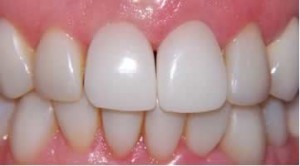
With the destruction of teeth, more than half, there is a need for prosthetics with crowns.
Tooth decay can occur for various reasons: with caries, as a result of injury and wear.
Undoubtedly, one can try to fill a tooth by “increasing” its crown part, but not the fact that such a filling will last for a long time under the influence of a chewing load. And if the teeth that are visible when smiling and talking are destroyed, then there can be no talk of any aesthetics at all.
But dental prosthetics is a long process. To prepare the teeth, making crowns will take at least a week.
Therefore, during the manufacture of permanent structures, in order to protect the sharpened teeth and enable the patient to feel more confident, it is recommended to fix temporary crowns on the front teeth.
Pros of temporary (provisional) crowns
The tooth after preparation looks very unsightly. The patient will experience discomfort and stiffness, which can be eliminated if you hide the honed tooth under a temporary crown.
Restoration by provisional constructions is used not only to mask the defect.
Temporary crowns perform other functions:
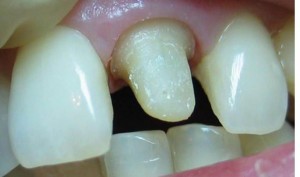
- Dull the sensation of pain if the nerve is not removed during turning.
- They prevent gum growth on the edge of the tooth, which will not interfere with further prosthetics.
- It protects against the penetration of microorganisms into the tissue of a sharpened tooth, thus preventing the development of inflammation.
- They give the tooth stability and prevent it from shifting to the sides.
- Accelerate the process of getting used to new teeth. A permanent construction will be a temporary copy, and the process of adapting to a new tooth will be faster.
- Contribute to the restoration of the functionality of a lost tooth.
- Provide normal diction.
What are they made of?
The material for temporary restoration of teeth, most often, is plastic (plastic).
But due to the fact that modern technologies do not stand still, in some clinics provisional crowns for the front group of teeth are made of composite materials (for example, acrylic and its derivatives).
Each of the materials has its own individual characteristics:
- Production time (can be manufactured within four minutes).
- Hardening rate.
- Different levels of toxicity.
- Convenience of modeling.
- The possibility of subsequent correction of the shape of the structure.
- Different degrees of strength.
- Life time.
Depending on the merits of the material, the cost of crowns varies.
Temporary plastic crowns are not without drawbacks.
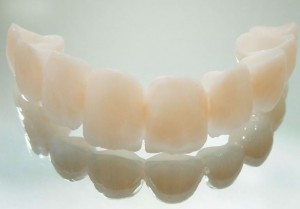
The disadvantages of plastic include:
- The porosity of the structure, due to which pathogenic microflora has every chance to penetrate deep into the material.Over time, microorganisms reach the stump of the tooth and become the cause of the inflammatory process.
- Change the original color. Some foods (coffee, black tea, red wine, etc.), nicotine can stain crowns.
- Short service life of temporary structures. It ranges from a few weeks to two years and depends on the conditions of manufacture: in the dentist’s office or in the dental laboratory.
Manufacturing techniques
Direct method
The manufacture of temporary structures takes place in the dental office.
- Making casts of softened silicone mass.
- Tooth preparation is performed.
- Plastic is poured into the mold and put on a prepared stump.
- The print is removed, and the hardened plastic structure remains on the turned tooth.
- With the help of a frieze, excess material is drained from the finished crown, after which it is ground and polished.
- The finished crown is fixed to the tooth using temporary cement.
Creating a provisional crown using this method takes no more than one hour.
Indirect method
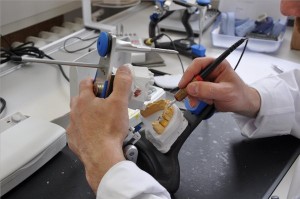
The manufacture of a temporary crown is carried out in a dental laboratory.
- Take molds with silicone mass.
- Two models are made of gypsum.
- The structure is modeled from wax.
The advantage of the indirect method of manufacturing a temporary prosthesis is the exact correspondence of the restoration to the anatomical features of the jaw. Such crowns are more durable and reliable.
Fixation
Regardless of what material modern crowns are made of, they are fixed on temporary cement. Temporary cement under the influence of saliva gradually dissolves.
Care
In order for the temporary restoration to last longer, it is necessary:
- Avoid chewing solid and sticky foods.
- Reduce the chewing load on that part of the jaw where the temporary structure is fixed.
- Carefully, carefully carry out dental care in the place where the temporary prosthesis is located.
- When using dental floss, do not pull it out, but pull it down, holding on to the ends. Then release one of the ends and pull effortlessly on the remaining end in the direction from the face.
Term of use
It is not recommended to tighten with replacement of provisional crowns.
Such designs are worn only until permanent prostheses are fixed.
If the crown has fallen out
- In case of slipping of the crown, it is necessary to visit the dentist to re-fix it on temporary cement. And while there is no way to get to the dentist, the design is better to return to its original place.
- At night and with food, such a structure is best removed from the mouth. You can store it in a glass of water.
Cost
Temporary tooth crown, price which varies depending on the advantages or disadvantages of the material - the cheapest and costs from 600 to 1000 rubles.
The price of permanent crowns for the front group of teeth depends on the number of designs, on the type of material from which they are made.
The cost of dental structures is influenced by the pricing policy of the clinic, the qualifications of staff
| Type of crown | Price, rub.) |
| Plastic crown | From 600 |
| Cermet crown | From 13000 |
| All-ceramic construction | 21000 |
| Zirconium crown | 27000 |
Before and after photos
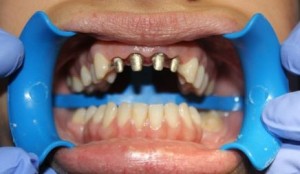 |
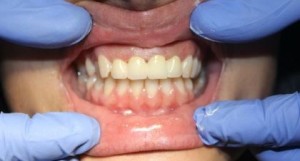 |
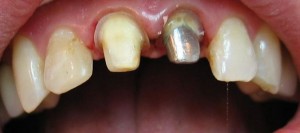 |
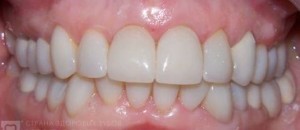 |
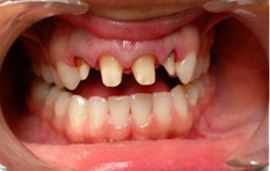 |
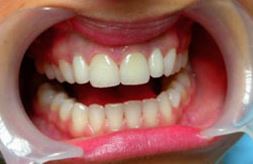 |